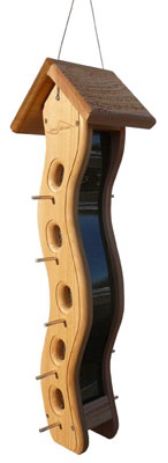-
why many a glass bird feeder aren’t glass at all
Take one classic bird feeder, craft it in solid copper, and add a circular perch… viola! You get the “Classic Copper Perch”. Yesterday a customer had inquired if the tube was glass, and to be honest, I had to open the box and inspect the feeder for the correct answer. It was not a glass bird feeder in fact, but a very thick poly-carbonate, or resin tube.
Now these feeders are considered higher end, and the person seemed a bit disappointed that it was “plastic”. And me too… until I started thinking about it.
Gone are the days of cheap plastics which yellow over time (except on cheap feeders). Very few feeders and houses use real glass, for a myriad of reasons: First and foremost is breakage. Be it pesky squirrels, or even a butter fingers accident, should a glass bird
feeder fall on concrete – it’s likely a gonner 🙁 Second: on birdhouses, glass would create an oven-like atmosphere during the heat of summer, making it too hot inside for nestlings. We feature an artist who does a wonderful fused glass birdhouse in vibrant colors, but the glass is actually fused to a real wooden nest box with proper ventilation.
Glass bird feeders like those crafted by Parasol are mostly for hummingbirds, and the hand-blown glass seems thicker and stronger than manufactured clear glass. Same for ceramics and stoneware, it seems more durable and stronger than mass-manufactured glass.
Whatever the material of your bird feeders may be, keeping them clean is important to birds’ health. And always take precaution against Houdini squirrels… they’re brutal!
-
Molting, migration and wild bird feeders
An interesting and well-written post in the Bluebird Monitors Forum.
Used with permission: by Keith Kridler, Mount Pleasant, TexasMolting and migration already underway in EXTREME drought:
Watch around your homes and yards and find this past breeding year plumage laying around observe how worn off the ends of the primary flight feathers and tail feathers are. Look to see how the color has been shed or worn off from these feathers. Or how these feathers now have lost the top layer of cells and do not “reflect” their true colors.
Feathers are REALLY high in protein, as birds are molting they require a diet higher in protein than they normally do.Flocks of grackles are arriving already. Hummingbirds are really beginning to flock to feeders. Only about half as many this year as in the past years possibly due to the severe drought this summer. In 2008 we had already fed over 50 pounds of sugar. This year we have only fed 20 pounds.
We are seeing small flocks of male Indigo Buntings everyday. Titmice and White Breasted Nuthatches are really busy as they empty the sunflower wild bird feeders and are stuffing extra seeds into holes and crevasses in bark. Scissor tailed flycatchers are moving through as are lots of other flycatchers. Inca and Mourning Doves as Bob mentioned are in very high numbers. Turkey and Quail breeding success was dismal across Texas this year.
Skunks, coons, possums and other four legged predators are moving to towns or raiding pet food and water dishes at rural homes. Wild Hogs are moving during the day and are actually breaking into bales of hay and eating grass as the soils are too hard to dig up roots. Hog scat is filled with bits and pieces of grasshoppers right now! Picture herds of 20 or more hogs out in pastures chasing large grasshoppers for a meal!
Small ponds in Texas are drying up or becoming toxic with stagnant water and or algae blooms. Small streams are powder dry. The Sabine River is dry almost 300 miles BEFORE it gets to the Gulf of Mexico. The Martin Lake coal fired power plant is running low on cooling water. Their average lake water temperature is now over 114*F or just about to the point where they are cooking fish and turtles.
Brutal heat continues locally with temperatures yesterday at 5 PM still at 106*F. The human population of Texas has tripled during HALF of a humans average lifespan. We moved past 25 million Texans now and are consuming 60,000 megawatts of electricity day after day during this heat.
Dry land farming has corn harvests in the state from 7 to 25 bushels of corn per acre….These should be from 100 to 125 in a normal rainfall year in this state or less than half of production from states in the “corn belt”.
-
A Groovy kind of tube bird feeder
You might call this a hopper type bird feeder, but it has perches and there’s no tray at the bottom. You could call it a tube bird feeder, but it really doesn’t resemble one of those either.
We call it the Wave Bird Feeder because of the groovy design. Hand crafted cedar and superb quality, this tube bird feeder is available for black oil sunflower and thistle seed too. With ten feeding ports and a four-pound capacity, it will entice many a feathered friend!
A quality tube bird feeder like this is a good investment for any backyard bird habitat. For use year-round, seed stays protected from the elements. If squirrels are a problem in your yard, a baffle is highly recommended to protect the feeder. Whether feeding sunflower or thistle, you can bet your birds will approve!



